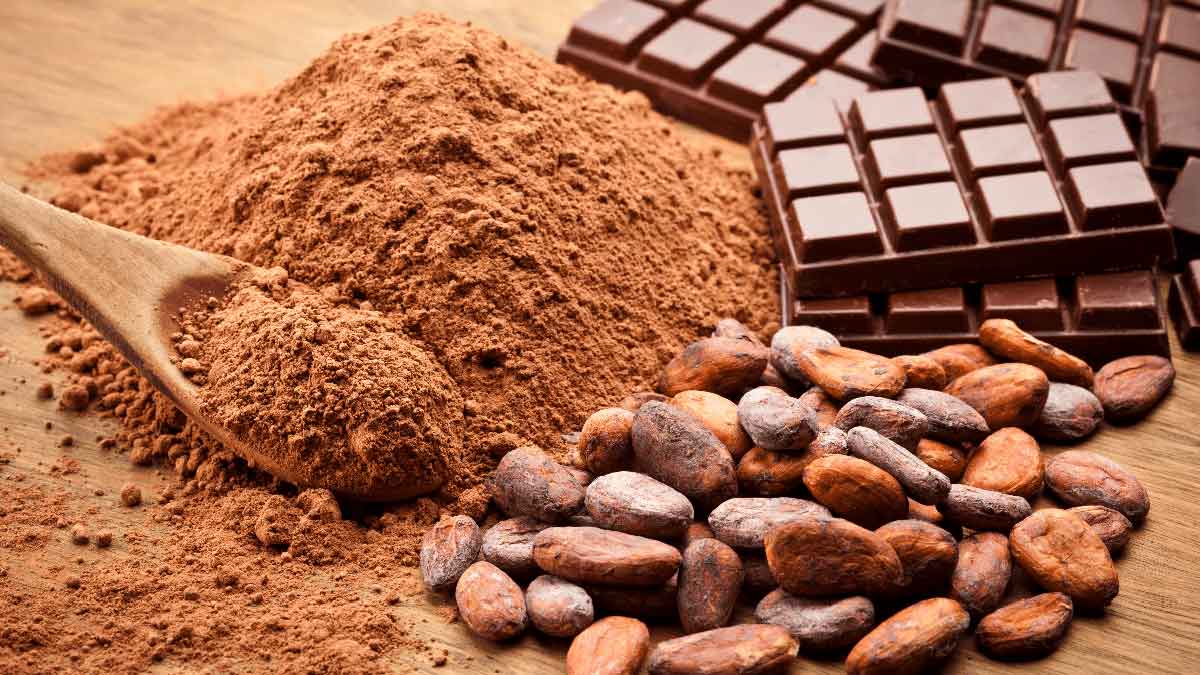Cacao seeds have been consumed for over 3,000 years by cultures such as the prehistoric Mayans for their wide range of health benefits (1, 2).
Documents reveal over 100 different medicinal uses such as the treatment of anemia, poor appetite, mental fatigue, constipation, and many others (3). Organic, raw cacao is a superfood that is full of phytonutrients, containing high amounts of iron, magnesium, sulfur and many more.
Best Cacao
1. Navitas Organics Cacao Powder
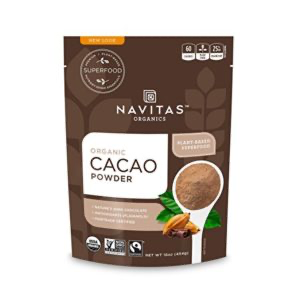
Navitas cacao powder proves to be the best product on the market for multiple reasons, but their biggest competitive advantage lies in their sourcing process. As an organic and fair trade certified product, it is guaranteed to be grown without the use of pesticides or other harmful chemicals. This includes the absence of cadmium, which should be a top priority when searching for the best cacao powders.
Navitas Organics Cacao Powder provides 25% DV magnesium, 10% DV iron and 18% DV fiber per serving. It is also certified USDA Organic, Fair Trade, non-GMO, kosher, vegan, gluten-free. For these reasons, it’s our #1 pick.
2. Viva Naturals Cacao Powder

Viva Naturals cacao powder is organically-sourced from Peru, making it of the highest quality. Though it is not fair trade certified, it is still free from cadmium and has also been highly rated as being safe as well. Viva Naturals Cacao Powder is unprocessed, retaining important nutrients like magnesium, calcium, iron, fiber and protein.
Compared to other powders on the market, it tends to have a more palatable taste and texture. Viva Naturals Cacao Powder is derived from prized Criollo cacao beans, revered as the highest quality variations of cacao, lacking traditional bitterness and offering exquisite chocolate taste.
3. Pure Natural Miracles Cacao Powder

Miracles Cacao powder, by Pure Natural Miracles’ distinguishes itself by their sourcing choices in addition to their formulation. In addition to its organically-sourced product from Ecuador, it is also unsweetened and completely raw which helps to preserve the natural health benefits generally received from its use.
Many reviews have reported this cacao powder to have a smooth and rich taste which is not often found when consuming raw cacao.
4. OMG! Superfoods Organic Cacao Powder

Though many cacao powder manufacturers have opted to use plastic bags for packaging purposes, OMG Superfoods has chosen to use a paper canister which sets it apart from its competitors. Unlike plastic bags, canisters fit in more locations and provide an easier storage option.
This cacao powder product is USDA certified organic, certified vegan and kosher.
5. Terrasoul Superfoods Cacao Powder

Though not as well-known as other brands, Terrasoul Superfoods produces a cacao powder that is just as high-quality. While it keeps pace with its organic and fair trade certification, it also provides a high degree of versatility.
Terrasoul raw cacao powder is certified organic, kosher, non-GMO project verified, fermented and naturally gluten-free.
6. Zen Spirit Cacao Powder
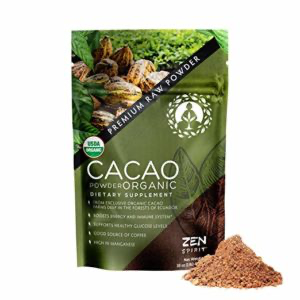
Though Zen Spirit’s cacao powder is fairly basic in terms of extras, it still hits the high points of other high-quality products. Their cacao beans are hand picked by the best, made into cacao nibs, then gently grinded in low temperatures to reach become the much less processed Cacao Powder, making it exceptional and highly beneficial for your overall health.
This cacao powder comes in a one-pound container and is fully raw and unsweetened. It is also certified organic with cacao sourced from Ecuador and includes a pleasant flavor.
7. Zint Organic Cacao Powder

Among the many cacao powder options, Zint’s organic cacao powder focuses on providing a high-quality product while also giving users a variety of choices to use. Zint is sold in several large grocery store chains in a variety of sizes from one to pounds making it ideal if you’re unsure as to the amount you’ll need to use.
Additionally, it is organically-sourced and hand harvested in Peru from USDA-certified organic, non-GMO, raw, vegan, gluten-free, non-alkalized cacao beans, harvested by hand in Peru.
8. Better Body Foods Organic Cacao Powder
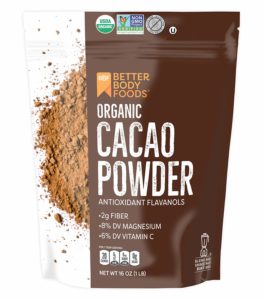
Better Body Foods manufactures an affordable organic cacao powder that is also very high-quality. Being non-GMO, gluten-free, and raw make this an ideal cacao product to obtain the best health benefits.
It’s organically-certified and sourced from Peru which also adds to its quality.
9. Andean Star Organic Cacao Powder
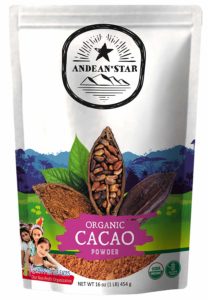
Sourced from Peru, Andean Star’s cacao powder is a non-GMO, gluten-free product that meets all of the requirements to make an effective and beneficial cacao powder.
Though it does not have some of the more popular elements found in the higher-ranked products, it still manages to bring an organically certified product with an appealing taste to the table.
10. Healthworks Cacao Powder

Healthworks’ Cacao Powder is one that doesn’t have a well-known name or brand, but it still manages to provide a solid choice for those looking to incorporate cacao powder into their diet regularly.
In addition to being organically-sourced from Peru, it is also sugar-free, non-GMO, keto and vegan-friendly making it useful to a wide array of users.
How We Rank
The majority of health benefits found through the use of cacao powder can be found in raw and unprocessed versions. We wanted to make sure that the cacao powders used in our rankings were certified organic when possible to ensure less of a possibility of exposure to chemicals or pesticides. This was not an absolute requirement but played a large role in the final rankings. Products such as Navitas and Pure Natural Miracles were given the top spots due to their certified organic products, in addition to their other benefits. We also focused on products that were fair trade certified. This international certification type helps to ensure a better quality product. Cacao powders that are fair trade certified, like Viva Natural’s, are traditionally more effective and robust than others.
Cacao is traditionally a crop found in South America, however, it was not a requirement that a product be sourced from these locations for our rankings. While we did give preference to cacao powders sourced from areas such as Ecuador and Peru, like Zint Organic Cacao Powder and Better Body Foods, we mainly focused on making sure that the source country was identified in the labeling. Knowing this information helps to ensure that fair trade and sourcing processes are met. If a product’s source was un-identifiable based on the information provided or research, it was eliminated from consideration.
One of the areas we wanted to put a key emphasis on was the additional ingredients included in each product. Though the majority of cacao powders are pure, there are some which may include elements that qualify them as cocoa powder. This is a key reason as to why popular cacao powder, Fu Carbs Keto Cacao, does not appear in the rankings.
Lastly, we wanted to make sure that the cacao powders used in our final rankings were as safe as possible. Cadmium is commonly found in cacao and could be toxic to the human body if consumed. This was a little harder to quantify, as not all products have undergone adequate testing. With this being the case, we limited our rankings to products that had verifiable claims of being cadmium-free. Products with unverifiable claims were not included in the final rankings.
Benefits
1. Cacao may improve cardiovascular health. Several studies demonstrated that following a diet abundant in phytonutrient-rich plant foods may reduce the development of diseases such as cardiovascular disease and even cancer (4, 5).
Research indicates that dietary phytonutrients reduce the development of cardiovascular disease by reducing oxidative stress and endothelial inflammation (6).
Cacao, thanks to its high phytonutrient content, is considered one of the most antioxidant-rich foods in the world (7).
Regular cacao intake was also associated with a 45% to 50% lower cardiovascular and all-cause death.
2. Cacao can lower blood pressure. Cacao has been shown to have a beneficial effect on vascular function, insulin resistance, blood pressure and more (8).
In a 2006 study that included 470 elderly men and followed over 5 years, authors found that the regular consumption of cacao was related to lower blood pressures (9).
Two recently published studies also demonstrated that cacao flavanols improve cardiovascular function by increasing blood vessel flexibility and lowering blood pressure (10, 11).
3. Cacao fights off aging. One 2014 investigated the effects of cacao on skin premature skin aging. The twelve-week double-blind clinical trial showed that patients who consumed the higher flavanol cacao powder reported firmer skin and less sun damage, versus the placebo group (12).
4. Cacao may help prevent anemia (iron deficiency). Iron is necessary for our red blood cells to carry nutrients and oxygen to our cells. Due to various contributing factors, iron deficiency is one of the most common forms of malnutrition. Globally, 50% of anemia cases are attributable to iron deficiency (13).
Iron deficiency can be prevented, and low serum iron levels can be corrected by increasing the consumption of iron-rich foods. Cacao, a rich source of dietary iron could, therefore, be helpful in preventing the deficiency (14).
1 ounce of dark chocolate contains about 20% of the RDA of iron, making it an excellent source. Raw cacao has even more (15).
There is another factor to take into consideration with iron, and that is absorption. Plants contain nonheme iron, which is not as easily absorbed as heme iron from animal sources. To enhance iron absorption, it is recommended to combine it with Vitamin C-containing foods. Luckily, raw cacao naturally contains Vitamin C, improving iron absorption (16).
5. Cacao can fight off chronic fatigue. The theobromine and phenylethylamine (PEA) in cacao are natural stimulants that can stimulate your body and mind to fight off tiredness. A 2010 study involving 24 healthy participants showed that cacao helped increase 24-hour ambulatory systolic blood pressure while lowering central systolic blood pressure (17).
Another 2014 study gave 42 healthy people a dose of cacao ranging from 300 to 1,000 mg. Five hours later, it showed that participants felt more alert and active due to a slight increase in heart rate (18).
6. Cacao can help to restore and create radiant skin. A 2014 double-blind study published in the Nutrition Journal showed that daily use of cacao decreased the appearance of sunspots and improved the skin’s elasticity and hydration levels (19).
The reason is that cacao is filled with a high amount of cellular repairing agents such as magnesium, fatty acids, antioxidants and vitamin C to rejuvenate your skin.
7. Cacao may help you lose weight. Growing research suggests the benefit of cacao in supporting weight loss. In a study published in 2005, cacao was found to prevent high-fat, diet-induced obesity. This weight loss-enhancing benefit of cacao was associated with its ability to positively influence lipid metabolism and decrease fatty acid synthesis (20).
A 2007 study published in the Journal of Discovery and Innovation showed similar results. In this 28-day rat study, scientists wanted to determine whether the theobromine component of cacao bean had an effect on weight loss. Results showed a significant and rapid weight loss along with improved blood cholesterol levels on day 28 (21).
8. Cacao can prevent sunburns. One London study published in the Nutrition Journal showed that subjects who consumed 20 grams of cacao were able to double their time in the sun without getting sunburnt (22).
9. Cacao has anti-cancer activity. It has been confirmed scientifically that cacao beans are rich in antioxidants, such as flavonoids, catechins, epicatechins and proanthocyanidins, and beta-sitosterol (23).
In an in vitro study researchers tested the potential cancer-protective effects of different flavonoids present in cacao beans on human prostate cancer cells. Study results revealed that cacao polyphenols inhibit the growth of cancer cells, without affecting the growth of normal cells (24).
In a 2009 review article cacao was found to reduce oxidative stress and thereby reduce the risk for cancer and other chronic conditions (25).
10. Cacao fights tooth decay. A 2013 study published in Oral Health and Preventative Dentistry set out to investigate the tooth strengthening of theobromine. The results showed that theobromine helped strengthen tooth enamel and thus protect your teeth from cavities and decay (26).
11. Cacao may improve cognitive function. A 2010 study with 30 healthy adults investigated the ability of cocoa flavonols to improve cognition. In this randomized, controlled, double-blind study, participants consumed 520 mg or 994 mg cocoa flavonol containing drinks over three different periods. The results showed an improvement in cognitive performance and a reduction in mental fatigue (27).
12. Cacao enhances your libido. Phenethylamine is an endorphin-releasing compound found in Cacao. A 2006 study involving 163 women showed that house who consumed cacao in the form of chocolate had a higher libido than those who didn’t (28).
13. Cacao may help prevent diabetes. Polyphenolic compounds, such as flavanols offer proven health benefits with no toxicity and low cost. Cacao, red wine and tea are all rich sources of flavanols. In a 2017 review article, researchers found that all three, cacao, tea and wine, may reduce diabetes risks (29).
In another study, cocoa compounds have shown to improve blood glucose homeostasis. Compounds found in cocoa exerted their anti-diabetic effects by stimulating glycogen synthesis and glucose uptake (30)
14. Cacao enhances mood. Chocolate, made from cacao beans, induces positive effects on mood. This mood-enhancing ability may explain why chocolate is often consumed under emotional stress (31).
Even though several clinical studies have confirmed this effect, the mechanism of action through which cacao enhances cognition and mood isn’t fully understood (32).
One study suggests that cacao’s rich antioxidant molecule content may be partially responsible for the beneficial actions in the brain (33).
One rat study evaluated the anti-depressant effects of cocoa polyphenolic extract. It is speculated that the improved mood is due to the high polyphenol content (34).
Another theory is that cacao raises the levels of different neurotransmitters, chemical messengers in the brain that affect our mood. Phenylethylamine (PEA) for example, is one of those chemicals that influences dopamine and serotonin production. PEA is naturally present in cacao bean, potentially contributing to its positive effect on mood (35).
15. Raw cacao powder provides a substantial amount of calcium. Though chocolate itself may not be considered overwhelmingly healthy, raw organic cacao has many health benefits. The natural compounds found in cacao can not only provide a variety of vitamins but also provide a substantial dose of calcium which could lead to healthier teeth and bones (36).
As calcium accounts for approximately 2% of body weight, it is essential in reaching optimum health. Raw cacao provides more calcium than that which is found in cow’s milk (standard cow’s milk provides 125 mg per 100ml of calcium, cacao provides 160mg per 100ml of calcium).
Calcium has been known to increase bone health and aid in the prevention of multiple diseases including osteoporosis and arthritis. Though raw cacao is beneficial, it is important to ensure you select products that are raw cacao rather than cocoa or chocolate that have been processed and will, therefore, provide fewer health benefits.
16. Cacao can decrease the frequency of anxiety. Raw cacao has been shown to contain multiple nutritional benefits that directly affect the mood centers within the brain and, therefore decrease the frequency of anxiety. Polyphenols found in cacao are natural compounds that serve as a mood enhancer and affect the psychiatric aspects of functionality. Raw cacao also provides salsolinol which further helps to stimulate the human brain and assists in the release of dopamine, a neurotransmitter in the brain.
According to a study conducted in 2011, raw and processed cacao is absorbed in the human body through various pathways. The effects on bodily function can decrease anxiety by approximately 10% if used daily for 6 weeks (37).
There have also been additional studies confirming these findings. As a result, cacao has become an increasingly prescribed cornerstone of good health.
17. Cacao powder can enhance heart health. Flavanols are the primary health component found in raw cacao and it has been linked to multiple health benefits. In addition to lowering the risk of heart attack, flavanols found in raw cacao has a favorable impact on circulation and blood vessel function. Healthy blood flow is imperative to the delivery of oxygen and nutrients throughout the body (38).
Cacao flavanols increase the production of nitric oxide. This ultimately causes thin muscles in the area of the blood vessels to relax and dilate which also regulates and control flow and pressure.
Side Effects
1. Cacao may hamper sleep. Since cacao contains caffeine, eating too much of it may cause caffeine-related adverse effects, such rapid heartbeat, restlessness, difficulty sleeping.
2. Cacao can cause IBS like symptoms. Cacao may cause GI disturbances such as constipation, nausea, gas, stomach pain (39).
3. Cacao may trigger a migraine in some individuals (40).
4. Commercial cacao may lead to weight gain. While cocoa has many health benefits, commercial chocolate and its products contain high amounts of sugar, fat, and additives, which are far from being healthy.
5. Cacao can cause skin issues. Cacao has been shown to cause acne and metals, such as nickel, that are present in cocoa can cause allergies, skin inflammation, and lesions (41).
Recommended Dosage
A normal dosage of theobromine ranges from 50 to ~1,000 mg, depending on the product. Dosages of 500 mg (2/3 a standard 70% dark chocolate bar) have the greatest benefits with little to no negative side effects (42).
However, there is no set standard dosage for cacao, and there are too many biological factors that interact with how it is metabolized in the body. The upper limit has been reported as 10kgs of chocolate in a single day, but again that number will vary based on your metabolism and size.
It’s more important to be aware of any pets consuming chocolate as they have a difficult time metabolizing theobromine and thus can be poisoned at much lower levels.
FAQ
Is cacao and cocoa the same thing? Raw cacao is made by cold-pressing un-roasted cacao beans. The process keeps the living enzymes in the cacao and removes the fat (cacao butter). Cocoa may appear to be the same, but it’s not. Cocoa powder is raw cacao that’s been roasted at high temperatures.
Is cacao really good for you? Cacao is full of health benefits and is a healthy option when it comes to indulgence, but it is possible to have too much of a good thing. Raw, powdered cacao is full of flavonoids, which act as natural antioxidants. Antioxidants protect the body from aging and disease caused by free radicals.
Is cacao powder good for weight loss? Evidence shows that cacao can help you lose weight and improve your blood lipid and glucose levels. But don’t forget that weight loss will only occur if you are in a calorie deficit – you burn off more than you put in your body. As an occasional treat, dark chocolate, cocoa powder or raw cacao are all fantastic.
Do cacao and cocoa taste the same? No, the alkalizing process used for cocoa production results in a balanced natural acidity, thus it tends to be a bit more mellow. In contrast, cacao retains more of the natural cacao bean taste.
Is cacao dangerous? In general no, cacao is not dangerous to humans. However, eating raw cacao in extreme excess could be dangerous. Theobromine poisoning has been reported to cause heart failure, seizures, acute kidney damage, and dehydration. It is much more dangerous to animals who have a very tough time processing theobromine and thus are more susceptible to theobromine overdose.
What are the side effects of cacao powder? Eating large amounts might cause caffeine-related side effects such as nervousness, increased urination, sleeplessness, and a fast heartbeat.
Is cacao good for skin? Studies show applying raw cacao offers a lot of the same benefits as eating it. The high levels of antioxidants protect and repair the skin from damage and premature aging. Also, it acts as a potent anti-inflammatory, soothing redness and blemishes while improving the skin’s complexion.
Is cacao good for cholesterol? Yes, science shows that cacao may boost good cholesterol.
What is the difference between cacao and cocoa butter? Raw cacao powder is made by cold-pressing unroasted cocoa beans. The process keeps the living enzymes in the cocoa and removes the cacao butter, which is the fat.
Can cacao keep you awake? Much like coffee, raw cacao contains caffeine, which acts as a stimulant. Caffeine can negatively affect sleep and may affect your kidneys. Cacao also contains theobromine, another stimulant.
Does cacao burn fat? Cacao or cocoa powder is said to improve fat metabolism and increase energy, and hence, can be consumed for quicker weight loss. If you wish to use cocoa powder to burn fat, then make sure you buy a good quality, organic brand, which has no sugar in it. Having a product with sugar, will take away from the fat burning effects, despite improving the palatability.
Why can’t animals eat cacao? Dogs cannot metabolize theobromine and caffeine as well as humans can. The substances accumulate in the animal’s body in an amount that can be toxic or even fatal.
Can cacao affect breastfeeding? Yes, the consumption of raw cacao can affect women while breastfeeding. Though there are significant health benefits for mothers, there are a few concerns related to infants when raw cacao is consumed in large amounts.
Should children consume raw cacao? The choice to allow children to consume raw cacao relies heavily on the individual involved as well as the age of the child. Studies have shown that raw cacao can be beneficial to children, however, there is an increased risk of hyperactivity in some children. With this being the case, it is recommended that you consult your child’s pediatrician before allowing consumption.
If approved, a minimal amount of cacao should be given at first to determine how consumption will affect your child and their tolerance level. If your child experiences adverse effects use should be discontinued immediately
Are there any benefits to cacao powder while pregnant? Yes, pregnant women can enjoy many of the health benefits related to cacao consumption while pregnant. There are some concerns, however, related to the growing infant if cacao is consumed during pregnancy. Ingestion of cacao during the later stages of pregnancy may result in constricting effects on the fetal ductus arteriosus. This could cause difficulty with blood flow in the unborn child and result in a variety of deficiencies and detriments.
It is therefore recommended that your doctor be consulted before consuming raw cacao during pregnancy at any stage.
Can raw cacao cause birth defects? Though there are very few studies conducted thus far, raw cacao is believed to be capable of causing birth defects. Cacao nibs, in particular, are teratogenic which has been linked to the occurrence of birth defects. The number of studies has been scarce on this particular subject, however, you should consult your OBGYN if you have concerns related to the possibility of birth defects due to cacao consumption
Can cacao intake help with stretch marks? At this time, there are no existing studies to confirm the benefits of cacao when used on stretch marks. Cacao butter is known to be a skin softener, however, so there is the possibility that long-term use may yield some results, however, there is no present evidence to suggest or confirm this. It is important to note that consumption of cacao directly has also not been studied for this particular purpose, so its efficacy can also not be confirmed in this situation.
Does cacao have an effect on children with autism? The number of studies conducted on this particular topic is minimal, however, there have been observations in which the antioxidant properties found in cacao may have a therapeutic effect on children diagnosed with autism (43).
As these studies are observational in nature, more information and exploration is needed to confirm findings. If the consumption of cacao is a consideration, it is recommended that you first contact your pediatrician to decided whether or not this would apply to your specific experience.
Can cacao nibs be eaten as a snack? Yes, raw cacao nibs can function as a snack option for those who prefer this method of consumption. In general, cacao nibs can be eaten directly from the packaging and result in little to no mess occurring. It is recommended that users be cautious of intake when choosing to consume raw cacao nibs directly due to the difficulty in measuring serving size.
Can you experience a cacao allergy? Yes, you can experience an allergy when consuming cacao. Though this is not a common experience, allergies occur when the body identifies a foreign substance as a threat so there is the possibility that your body may react poorly to cacao. In many cases, cacao allergy is triggered by the presence of caffeine which will normally cause symptoms such as jitteriness or dizziness. In most cases of cacao allergy, symptoms will be mild to moderate with the presentation of a rash or hives. If an allergy is suspected, it is recommended that you stop the consumption of cacao and consult a physician.
Recap
Cacao is one of the healthiest superfoods on the planet helping fight off obesity, heart disease, and high blood pressure. However, the typical method of consuming cacao, via chocolate, can be more damaging than healthy, as it is still loaded with calories and refined sugar.
High-quality dark chocolate (usually 70% or more) is your best option as it has the highest cacao content and the lowest amount of refined ingredients.
For Healthtrends #1 Cacao recommendation, click here.
